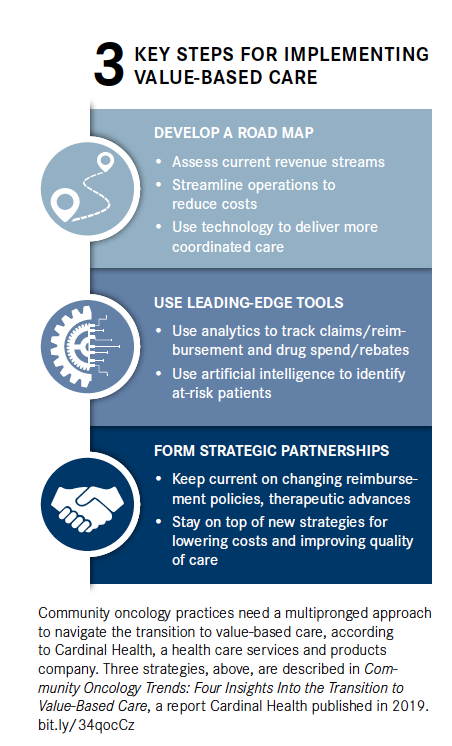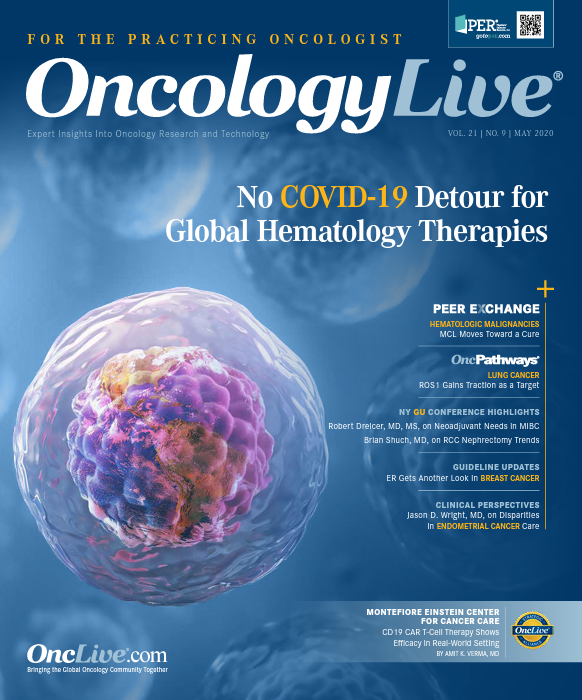Value-Based Oncology Models Loop In Patients and Referring Physicians
Given the national push for value-based care, oncology practices such as Minnesota Oncology are modifying their treatment models to better coordinate care not only with patients but also with referring physicians.
Bhuvana Sagar, MD

Bhuvana Sagar, MD
When patients at Minnesota Oncology experience certain adverse effects from cancer treatment, such as new or worsening pain, they don’t have to leave a phone message for their doctor. A trained receptionist puts them through immediately to an advanced-practice practitioner (APP).
Yes, the practice had to hire more staff—at least 8 nurses or APPs for their 12 offices—to handle phone calls and same-day appointments. But now patients are less likely to go straight to the emergency department (ED) or call another health care provider, who might send them to the ED or urgent care.
Given the national push for value-based care (VBC), oncology practices such as Minnesota Oncology are modifying their treatment models to better coordinate care not only with patients but also with referring physicians. The redesigned models give patients more holistic care and simplify the process for referring practices, where doctors receive copies of patients’ detailed care plans during treatment and survivorship. These plans guide patients and referring physicians in understanding what symptoms might be related to cancer care and should prompt a referral back to the oncologist.
Payers have also adopted VBC models, providing more hands-on assistance to patients and medical practices. This approach also can affect referring practices by decreasing hospital and ED usage and coordinating care to guide the patient throughout the process.
Cigna, for example, began VBC programs in 2008, introducing Cigna Collaborative Care in 2014. This accountable care arrangement provides practices incentives for health outcomes and patient experiences and also lowers costs, said Bhuvana Sagar, MD, an oncologist and Cigna’s national medical executive. The company added oncology practices to this model in 2015 and now works with 8 large oncology groups, including Memorial Sloan Kettering Cancer Center in New York, New York, which joined in 2019.1
Coordinating Care
In its oncology model, Cigna enrolls and helps manage care after patients start on cancer therapy, Sagar said. After being alerted by a participating practice that a patient has started treatment, Cigna provides the oncology practice with daily census reports indicating when a patient is hospitalized, because some patients may not alert their doctor or may go to facilities where their oncologists do not have privileges. The practice can contact the patient, help coordinate care, and assist with discharge planning. Cigna’s case managers also reach out to patients to help coordinate or provide services throughout their care.
When onboarding a new oncology practice, Cigna helps hammer out an action plan, identifying areas of focus, such as how to keep patients out of the hospital. The process is customized because each practice operates differently, but the plan is based on how to improve quality and decrease costs, including hospital spend. The oncology practice provides a single point of contact, usually a nurse or APP, to coordinate care with Cigna. The company has a case manager, an oncology care coordinator, and a nonclinical person for benefits assistance. Cigna can also provide or refer patients for benefits that not all oncology practices offer, such as behavioral health counseling and referral to community resources.
Minnesota Oncology has several valuebased payer agreements, including with Humana and Blue Cross and Blue Shield of Minnesota (BCBS). “We have a number of patients under value-based care models,” said Rhonda Henschel, MBA, director of VBC commercial programs at McKesson and The US Oncology Network and interim quality director for Minnesota Oncology, which is a member of the network.
One helpful aspect is the “stoplight report,” which provides patient information and includes a checklist and status of interventions. That might include one-onone chemotherapy education appointments, oncology-specific nutrition therapy, and financial counseling, as well as a written treatment plan with prognosis, expected treatment response, medications, and alternative treatments. The plan also addresses proactively integrating palliative care services for symptom management and psychosocial support.
Keeping Patients Out of the Hospital
Managing symptoms and avoiding costly and unnecessary hospital care is a VBC goal. To that end, the written treatment plan lists not only expected symptoms during cancer treatment but also unlikely ones—important information for both patients and referring physicians, said Paul J. Thurmes, MD, an oncologist and medical director of Minnesota Oncology.
Click to Enlarge

Minnesota Oncology uses software called Navigating Care, which is helpful during both active treatment and years later. When patients share information on their symptoms via the software, the office can reach out to address potential problems earlier, Henschel said.
The practice also reserves time for unexpected appointments, such as to see a patient who reports pain and believes their cancer returned, Thurmes said. “We have a clinic set up with dedicated spots to see an APP or a physician, and we can get them in quickly,” he said.
The goal should be to check on patients before their symptoms get severe enough to send them to the ED. Bringing patients to the practice for assessment, hydration, or antiemetics or to ensure they have their medication or understand how to take it can prevent hospitalization, Sagar said.
Moving Into Survivorship
When patients at Minnesota Oncology transition to survivorship, they meet with staff to discuss what to expect, including surveillance visits, testing, healthy behaviors, and worrisome symptoms to monitor. The practice also gives patients and their primary care physicians a survivor plan for what to expect going forward.
“We find that when people finish treatment, they have anxiety about what to do next,” Thurmes said. They are accustomed to seeing their oncologist weekly for several months, and in this new phase, the visits drop dramatically. The plan gives them and their primary care physician a tool to move ahead and provides a connection to maintain that safety net.
The plan notes signs and symptoms of recurrence, so if the patient sees a doctor for pain, the doctor can check if it may be related to a recurrence or adverse effect before providing treatment. “We try to make it as easy as possible to focus on things that should trigger them to refer the patient back to oncology,” Henschel said.
Calculating the Costs of VBC
“We’re thinking about quality and affordability, but the patient is thinking about whether they can go back to work and whether they have money for food, co-pays, and childcare,” Sagar said. Assessing patients holistically, including behavioral health conditions, can significantly affect the total cost of care, she said, and influence whether patients are adhering to treatment or will end up in the ED. Evaluating and understanding these challenges and referring patients to appropriate resources can help decrease inpatient care, Sagar said.
VBC models do have increased infrastructure costs. Cigna provides an up-front care coordination fee to the oncology practice, and the practices also make investments. “They have to add additional staffing, and they can’t do this program just for 1 payer,” Sagar said. Increased staffing and coordination are key to seeing and assessing patients instead of routing them to the ED.
With other financial incentives in place, Cigna tracks quality metrics. The care coordination fee is paid regardless of other incentives to help with coordination costs. But payers such as Cigna want to know if the practice is providing care that is better than its baseline and the national benchmark. “If yes, we reward them with 50% of the savings they drive,” Sagar said. “They have to meet certain quality toll gates before they get to incentive payments; it’s not just about decreasing utilization.”
Analyzing the Results
Since Cigna started working with oncology practices in 2015, the company has seen an overall decrease in ED visits and length of stays, Sagar said. Practices have been asked to offer extended hours, making sure patients can reach a clinician and know whom to call.
But metrics are challenging, according to Henschel. Time must elapse to measure savings, and patients must first complete the cycle of diagnosis and chemotherapy or other treatment. Metrics are often measured in 6-month intervals, and claims take about 90 days for processing of all health care services. Then there’s a time lag for analytics. Minnesota Oncology has not yet reached the end of its first reporting period for Humana and signed a 5-year collaborative agreement with BCBS that became effective in September 2019.2
However, the practice receives high marks on survivorship satisfaction surveys that ask whether patients would refer a friend for similar services. “Patients appreciate the written documents for the road map and reassurance at the beginning and end of treatment,” Henschel said. It helps ease anxiety of the unknown.
Implementing Best Practices When Not in VBCs
Basic workflows can apply across the patient population regardless of specific payer VBC involvement, but these models have tools and mechanisms that focus on covered patients, including tracking and stoplight reports, Henschel said.
One of Minnesota Oncology’s biggest changes, a workflow used for all patients, transfers patients calling with new or worsening pain to APPs. “We knew that in a lot of cases, if someone is having new or worsening pain and we take a message, they may opt to go to the ED,” Henschel said. The practice changed its infrastructure to implement the plan, hiring 8 triage nurses to serve these patients. A telephone operator follows an algorithm to direct the patient’s call.
The practice also has standing orders so members of the care plan team can refer patients for services, including palliative care and a consultation with a dietitian, even if they’re not part of a VBC, Thurmes said. “We do this because it’s right for the patient,” he said.
The physicians make themselves readily available to referring providers via office or cell phone. Timely assistance benefits not only patients but also makes treatment easier for a referring physician and may help the patient avoid more expensive care.
References
- Cigna. Cigna collaborates with Memorial Sloan Kettering to improve care for people with ongoing cancer treatment. News release. July 24, 2019. Accessed April 9, 2020. bit.ly/2UVUtyo
- Blue Cross and Blue Shield of Minnesota. Blue Cross and Blue Shield of Minnesota and Minnesota Oncology announce fiveyear collaboration [news release]. August 22, 2019. Accessed April 9, 2020. prn.to/2RpygGw
“There’s a perception in the community that if you’re getting treatment in oncology, it’s chemotherapy and, therefore, nausea and vomiting are expected,” he said. “A lot of treatments would not cause that.” The written plan alerts physicians that an unexpected symptom might stem from another issue. Although most patients call their oncologist first during treatment, some may consult a primary care physician about a symptom needing attention.




